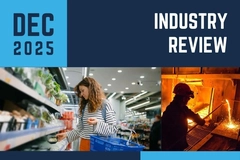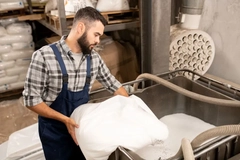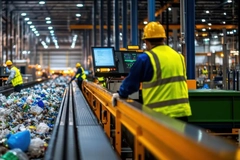Recycling in Vietnam: Study suggests national DRS to accelerate circularity and design innovation

Vietnam could divert up to 77,000 metric tons of packaging waste from landfills and cut 265,000 metric tons of CO2 emissions annually by implementing a DRS, according to findings released by the Norwegian Embassy in Vietnam and the Vietnam National Plastic Action Partnership.
The study proposes a mandatory DRS for single-use PET bottles and aluminium cans, recommending a refundable deposit of VND1,000 (US$0.03) to VND2,000 (US$0.06) per item. The proposed system aligns with Vietnam’s EPR policies and supports the country’s goals to reduce marine plastic pollution and achieve net-zero emissions by 2050.
In 2022, Vietnam was the first Southeast Asian country to issue a decree mandating packaging, recycling, and waste treatment obligations for manufacturers and importers.
The study was conducted by Eunomia Research & Consulting, and commissioned by the Norwegian Embassy in Hanoi and national development bank Innovation Norway, in consultation with Vietnam’s Ministry of Agriculture and Environment.
Chris Sherrington, head of environmental policy and economics at Eunomia Research & Consulting, tells Packaging Insights: “The study reveals that while Vietnam has introduced progressive policies to address plastic waste, including EPR under the 2020 Law on Environmental Protection and targets set out in the National Strategy for Integrated Management of Solid Waste, these frameworks are still in the early stages of implementation.”
 The study suggests that the DRS has the potential to stimulate the recycling industry in Vietnam.“The report highlights the importance of integrating informal workers into a future DRS through registration, collection fees, and supportive infrastructure. It recommends clear, fair processes and ongoing consultation to ensure that waste reclaimers can benefit from the implementation of a DRS, and Vietnam delivers a just transition as part of the shift to a structured, inclusive, and environmentally effective DRS.”
The study suggests that the DRS has the potential to stimulate the recycling industry in Vietnam.“The report highlights the importance of integrating informal workers into a future DRS through registration, collection fees, and supportive infrastructure. It recommends clear, fair processes and ongoing consultation to ensure that waste reclaimers can benefit from the implementation of a DRS, and Vietnam delivers a just transition as part of the shift to a structured, inclusive, and environmentally effective DRS.”
Implementing functional waste policies
As the findings are unveiled, the Norwegian Ambassador to Vietnam Hilde Solbakken emphasizes the system’s potential as a practical solution for improving waste management. She says that DRS has helped her country in achieving one of the highest recycling rates for plastic bottles in the world, surpassing 90%.
Norway is one of the first countries globally to establish a DRS, dating back to 1902. The country installed around 3,900 reverse vending machines (RVM) at 3,500 collection points for the automated return of empty containers.
The study is intended to support Vietnam’s Ministry of Agriculture and Environment in its future policy development.
“The legislation sets ambitious goals, including a 90% municipal waste recycling rate by 2050 and mandatory recycling targets for PET and aluminium packaging. Currently, however, the indications are that only 15% of municipal solid waste is recycled,” says Sherrington.
He points out that in Vietnam, recycling is mostly done by the informal economy, and about 60% is disposed of in an uncontrolled manner, including unmanaged dumpsites, open burning, and littering.
“Implementation of fully functional waste policies, adequate waste infrastructure, supportive economic frameworks, and effective regulatory controls are, therefore, needed with urgency to deliver the practical impact required.”
Packaging design drives efficiency
To maximize collection and recycling rates, Sherrington notes that the industry should also improve the packaging design for efficient collection, sorting, and high-quality recycling within the DRS infrastructure. The packaging industry need to design beverage containers that are suited to Vietnam’s context and are recyclable within DRS.
The packaging industry need to design beverage containers that are suited to Vietnam’s context and are recyclable within DRS.
“Packaging design must prioritize material compatibility, standardization, and traceability. The system initially targets PET bottles and aluminium cans, which together comprise 98% of Vietnam’s single-use beverage containers, and have high potential for closed-loop recycling.”
“Container labels should include standardised DRS markings and barcodes to facilitate effective identification in the case of manual returns, ensure compatibility with RVM and for fraud prevention purposes,” he says.
“Very small containers (<150 mL) and large containers (>3 L) are excluded due to practical challenges in barcode placement and RVM compatibility. Additionally, packaging should avoid materials that complicate recycling, such as composite layers or non-recyclable caps.”
DRS installation
Sherrington shares that the success of a DRS in Vietnam hinges on several factors.
“First, the system must be mandatory, aligning with Vietnam’s existing EPR legislation to ensure full participation from producers and retailers. A single system operator, operating on a non-profit basis, is recommended to manage logistics, finances, and data efficiently.”
“The DRS must be tailored to Vietnam’s context, particularly by integrating the informal sector, which currently collects the majority of recyclable materials. Waste reclaimers should be incentivized through a collection fee and supported via registration and training. Retailers and junkshops should be compensated via service fees to ensure widespread return point coverage.”
“To ensure integrity, the system must use registered barcodes and readable DRS labels on in-scope containers, with secure data systems for verifying returns. Strong government oversight, clear legislation, and ongoing stakeholder engagement are also critical,” he concludes.










